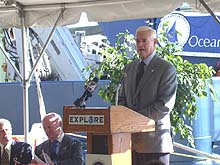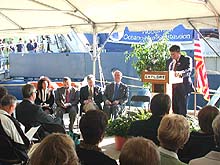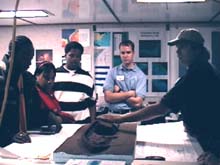
Senator Hollings of South Carolina was honored in Charleston for his years of support to ocean exploration. Click image for larger view.

Representatives from many organizations gathered to honor Senator Hollings. Click image for larger view and more information on the presenters.
Charleston Ocean Exploration Days
October 1, 2001
John McDonough
Project Coordinator
Islands in the Stream
By early Monday morning, the strong winds that had driven us from the Charleston Bump on Friday evening had dropped significantly and had headed north, wrapping tightly into a low pressure system that is pounding the coast of New Jersey. Here at the pier in Charleston, clear skies, light winds, and mild temperatures combined to set the stage for a ceremony honoring Senator Hollings of South Carolina for his years of hard work and dedication in promoting our Nation's exploration of the oceans. A ceremony which also recognized two major expeditions -- "Deep East" which used the Woods Hole Oceanographic Institution's (WHOI) Alvin submersible to explore deep water banks, canyons, and chemosynthetic communities associated with gas hydrate vents, and our own Islands in the Stream expedition. The day's festivities also provided an opportunity for middle and high school students from Georgia, South Carolina, and North Carolina to tour four vessels that have actively engaged in ocean exploration and research in the South Atlantic Bight this year -- the Harbor Branch Oceanographic Institution's (HBOI) R/V Seward Johnson II, the R/V Atlantis II from WHOI, the NOAA R/V Ferrel, and the South Carolina Department of Natural Resource's R/V Palmetto which conducted complementary operations with us during our missions to the Savannah Scarp and Charleston Bump. These students were able to learn about the exploration and research we have been conducting by talking directly with the scientists and crew members, and were also able to view the submersible and ship's bridge to learn about how we are able to visit these deep sea environments.

Jeff Johnston of the Monitor National Marine Sanctuary tells students about the recovery process. The Seward Johnson II left for the Monitor site later that day with Jeff aboard. Click image for larger view.
So where do we go from here? Last reports were that "Murphy" had left Cape Hatteras and is playing havoc along the coast of New Jersey, traveling toward Nova Scotia with the storm and leaving behind fairly calm conditions. Therefore, the crew of the R/V Seward Johnson II and a small team of scientists are steaming north, hoping to get in a couple of days of submersible diving on the wreck of the USS Monitor before Murphy returns. The objectives are simple and straightforward: to video document the condition of the wreck given the recovery of the engine this past summer, and to collect enough information to begin planning for the next major recovery effort, the gun turret, which is currently pinned in the muddy sediments beneath the stern of the wreck. As all good sailors, we are keeping our fingers crossed, for we realize that despite the best predictions, the weather at Cape Hatteras often does not follow the rules and can change from calm lake-like conditions to raging seas and howling winds in what seems like an instant.
Sign up for the Ocean Explorer E-mail Update List.











































